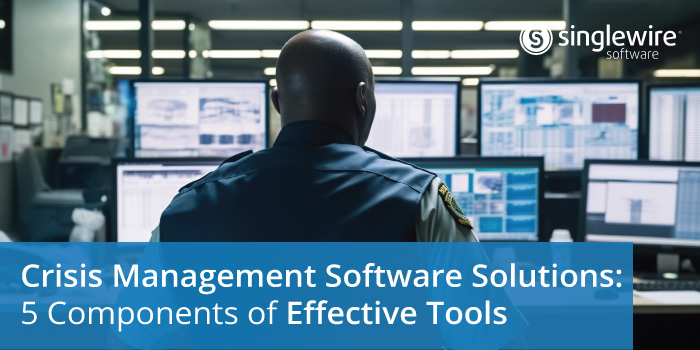The Essential Role of Crisis Management Software Solutions
Organizations face a wide range of potential crises that can significantly impact their operations, reputation, and the safety of their employees. Whether it’s a natural disaster, a cyber attack, or a public health emergency, being prepared with effective crisis management software solutions is essential to mitigate risks, ensure efficient response, and safeguard the well-being of the organization and its stakeholders. In this blog post, we’ll cover the importance of these tools and the five components that create effective solutions.
The Importance of Crisis Management
The consequences of being unprepared for a crisis can be severe. Without proper planning and tools in place, organizations may face confusion, delays in response, and increased vulnerability to potential threats. To avoid these risks, organizations must invest in robust crisis management software solutions that empower them to plan, respond, and recover effectively when faced with unexpected events. However, not all tools are created equal. Here are five components organizations should consider when looking for an effective solution.
- Automated Alerting: Automated alerting serves as one of the fundamental components of effective crisis management software solutions. In times of crisis, every second counts, and having a system that can automatically alert the necessary stakeholders is crucial. Having sensors and parameters set up that initiate alerts can greatly reduce the time it takes to share information. Whether it’s sending notifications via SMS, email, voice calls, or push notifications to mobile devices, automated alerting ensures that officials inform the right people promptly, enabling them to take immediate action.
- Message Customization (Prepare for Any Scenario): No two crises are the same, so organizations must effectively communicate in a range of scenarios. Crisis management software solutions that offer message customization capabilities allow organizations to tailor their communications to specific circumstances. From severe weather events to data breaches, having the ability to quickly draft and distribute targeted messages ensures that the right information reaches the right people, minimizing confusion and facilitating a coordinated response.
- Multichannel Communication: In a crisis, communication is paramount. To ensure that officials convey information quickly and efficiently, crisis management software solutions should provide multichannel communication capabilities. This means being able to reach stakeholders through various communication channels such as phone calls, SMS, email, social media, and even digital signage. By leveraging multiple channels, organizations can enhance the reach and impact of their messages, ensuring that officials deliver critical information even in situations where traditional channels might be compromised.
- Virtual Collaboration: Effective crisis management often requires coordinated efforts from multiple teams and stakeholders, even if they are physically dispersed. Virtual collaboration tools, integrated within crisis management software solutions, facilitate real-time communication and collaboration among team members, regardless of their geographical location. Features such as shared workspaces, document collaboration, and live chat enable teams to work together seamlessly, make informed decisions, and respond swiftly to evolving situations.
- Real-Time Insights: To manage a crisis effectively, organizations need access to real-time insights and data. Crisis management software solutions that provide real-time monitoring, analytics, and reporting capabilities allow organizations to gather valuable information about the crisis as it unfolds. This enables them to make data-driven decisions, identify emerging patterns or trends, and adjust their response strategies accordingly. Real-time insights also facilitate post-crisis evaluation, helping organizations learn from their experiences and improve their crisis management protocols.
Finding the Right Crisis Management Software Solution
Implementing comprehensive crisis management software solutions is an essential step for organizations looking to enhance their crisis preparedness and response capabilities. When evaluating various software options, consider the five components discussed above to find a well-rounded solution
Look for a solution that can seamlessly integrate with your existing technology infrastructure and adapt to your organization’s specific needs. Consider the scalability and flexibility of the software, ensuring it can accommodate both small-scale crises and large-scale emergencies. Additionally, prioritize solutions that offer user-friendly interfaces and intuitive workflows, enabling efficient adoption and effective utilization of the software during the stressful and time-sensitive moments of a crisis.
A crisis management software solution is an indispensable tool for organizations seeking to mitigate risks, respond promptly, and recover effectively when faced with unexpected events. By investing in automated alerting, message customization, multichannel communication, virtual collaboration, and real-time insights, organizations can effectively navigate crises, safeguard their stakeholders, and maintain their operational continuity.
At Singlewire Software, we understand the importance of crisis management and offer comprehensive software solutions to meet your organization’s needs. For more information on crisis management software solutions and how to empower your organization to be prepared and resilient in the face of any crisis, explore our InformaCast solution.
